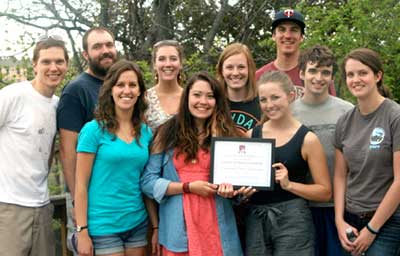Support for Female Students at the University of Denver
Davor Balzar, University of Denver

Members of University of Denver Society of Physics Students (SPS) at the Elitch’s amusement park (Denver, May 7, 2015). First row, first from left is our SPS adviser, Professor Mark Siemens.

Members of University of Denver Society of Physics Students after receiving University of Denver’s Outstanding Student Organization Award in 2014. First from left is our SPS adviser, Professor Mark Siemens.
The Department of Physics and Astronomy at the University of Denver is a small program in terms of the number of students (about 65 undergraduate and 25 graduate, as of May 2015). Historically, we have had a relatively large percentage of female students at both the undergraduate and graduate levels. APS ranked the University of Denver during the period 2011-2013 (see the Top Educators page), in second place (50%) for degrees granted to undergraduate female students, and sharing third place (also 50%) for degrees granted to graduate female students.
As I reflected upon the reasons why our program ranks high in percentages of female students, I took a look back in time. Since 1991, the percentage of female bachelor and PhD degrees in our program significantly fluctuated, but was regularly above the national average and in some years reached 100%. During the period of 1991-2015, our average percentage for undergraduate degrees by female students was 42%. As our program was relatively small until about eight years ago, the large fluctuations are expected. However, when our program began to grow (the number of majors increased about ten-fold in the last eight years), the percentage of female students also increased. We cannot assign the high percentage of female students to a single factor. The fact that we have had a critical mass of female students likely plays an important role in attracting other female students, as many of them might feel intimidated to be in an almost 100% male environment. This aligns well with reports of importance of the critical mass in cohort building and retention of graduate students [Panel Session II Building Successful Graduates: Definitions, Admissions, Retention, APS Graduate Conference, February 2013] and is likely to apply to the gender factor, as well. Along those lines, active Society of Physics Students (SPS) or other student organizations may play an important role. Our SPS chapter recently won the 2015 Blake Lilly Prize for physics outreach and the University of Denver’s Outstanding Student Organization in 2014 (see photo above). It is interesting to note that our chapter has had a high percentage of female students (68% among regularly active members) with female students regularly elected as our SPS officers (currently, eight out of nine members of the executive committee are women) and have frequently led different initiatives, such as Physics Night at Elitch’s amusement park and physics demonstrations for K-12 students from the Denver area (see photo on top right).
Another factor that I believe positively impacted our female student enrollments was the rejuvenation of our department that occurred over the last nine years, during which we replaced eight out of ten tenure-track positions. In particular, the fact that three out of eight of our new hires were women, was certainly extremely important for attracting and retaining female students, as it is well known that role models have a positive impact on the retention of female students [Best practices for female graduate students].
Lastly, from both my own and my colleagues’ anecdotal experience, which is based on feedback received from departing seniors over the years, there is an overwhelming impression that it might be easier for women to thrive in smaller academic programs. A hallmark of all departments with a small number of majors is their ability to offer more substantial support, both in and out of the classroom. As much as this is helpful to both men and women, female students might appreciate this environment more as they are frequently more likely to become victims of old “sciences are not for women” labels and, hence, are less likely to change majors if they receive constant support and encouragement. This might explain the fact that we have consistently had a relatively high percentage of female students for at least 25 years.
In summary, it would be an oversimplification to assign a single reason to a high percentage of female majors. However, our own experience has shown that a strong extracurricular effort, such as an active Society of Physics Students chapter, may play an important role in building a cohort and letting female students express their leadership potential. Furthermore, female faculty members are extremely helpful in supporting and guiding female students by example. Finally, smaller programs may be in a better position to support female students, and once their numbers reach critical mass, it might be easier to attract additional female majors, as well as to increase their retention.
Davor Balzar has been chair of the Department of Physics and Astronomy at the University of Denver since 2006. He received the University of Denver’s Faculty Service Award in 2010 for his efforts to rejuvenate the department. His research is in studies of crystalline defects and disorder by diffraction methods in ferroelectrics, photovoltaics, and oxides. He was elected a Fellow of the International Centre for Diffraction Data (ICDD) in 2006 and currently serves as Vice-Chairman of the ICDD Board of Directors. He can be reached at balzar@du.edu.
Disclaimer – The articles and opinion pieces found in this issue of the APS Forum on Education Newsletter are not peer refereed and represent solely the views of the authors and not necessarily the views of the APS.
